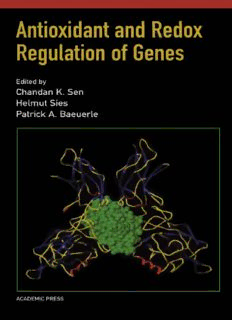
Antioxidant and Redox Regulation of Genes PDF
Preview Antioxidant and Redox Regulation of Genes
Antioxidant and Redox Regulation of Genes This Page Intentionally Left Blank Antioxidant and Redox Regulation of Genes Edited by Chandan K. Sen Lawrence Berkeley National Laboratory University of California Berkeley, California and University of Kuopio Kuopio, Finland Helmut Sies Heinrich-Heine-Universit~it Dtisseldorf, Germany Patrick A. Baeuerle Micromet GmbH Martinsried, Germany Academic Press San Diego London Boston New York Sydney Tokyo Toronto Front cover photograph: NF-KB p65 homodimer. A redox-sensitive transcription factor. Courtesy of Drs. Y. F. Wang and A. Sarai, RIKEN Gene Bank, Japan. This book is printed on acid-free paper. ~) Copyright (cid:14)9 2000 by ACADEMIC PRESS All Rights Reserved. No part of this publication may be reproduced or transmitted in any form or by any means, electronic or mechanical, including photocopy, recording, or any information storage and retrieval system, without permission in writing from the publisher. Academic Press A Division of Harcourt, Inc. 525 B Street, Suite 1900, San Diego, California 92101-4495, USA http://www.apnet.com Academic Press 24-28 Oval Road, London NW1 7DX http://www.hbuk.co.uk/ap/ Library of Congress Catalog Card Number: 99-63956 International Standard Book Number: 0-12-636670-5 PRINTED IN THE UNITED STATES OF AMERICA 99 00 01 02 03 04 MM 9 8 7 6 5 4 3 2 1 Contents Contributors xv Foreword xxi Luc Montagnier Preface xxiii Reactive Species as Intracellular Messengers Signaling by Singlet Oxygen in Biological Systems Lars-Oliver Klotz, Karlis Briviba, and Helmut Sies I. Singlet Oxygen in Biological Systems 3 II. Effects of Singlet Oxygen on Gene Expression 6 III. Comparison of Effects of Singlet Oxygen and Other Oxidants on the AP-1 Pathway 7 IV. Induction of Transcription Factors by Singlet Oxygen: Mechanism 9 References 14 Contents 2 Redox Regulation of Gene Expression Dana R. Crawford, Toshihide Suzuki, and Kelvin J. A. Davies I. Introduction 21 II. Methods of Analysis 22 III. Modulation of Nuclear Gene Expression 24 IV. Modulation of Mitochondrial Gene Expression 28 V. Stable versus Transient Gene Expression 29 VI. Modes of Regulation 31 VII. Oxidant Stress-Related Pathologies 33 VIII. Concluding Remarks 37 References 39 3 Rac, Superoxide, and Signal Transduction Hamdy H. Hassanain and Pascal J. Goldschmidt-Clermont I. Introduction 48 II. Activation of Rac Proteins 50 III. Rac and Respiratory Burst in Phagocytes 52 IV. Rac in Nonphagocytic Cells 54 V. Rac and ROS Production 57 VI. Rac and the Cytoskeleton 63 VII. Rac Gene in Development 66 VIII. Oxidative Burst in Plants 67 References 69 4 Redox Regulation of Ion Channels Suneil K. Koliwad, Anna K. Brzezinska, and Stephen J. Elliott I. Ion Channels 81 II. The Patch Clamp 85 III. Redox Regulation of Ion Channels 87 References 101 Contents vii 5 Cell Ca2 + in Signal Transduction: Modulation in Oxidative Stress Julio Gir6n-Calle and Henry Jay Forman I. Ca z+ in Signal Transduction and Cell Death 106 II. Lethal Alterations of the IntraceUular Ca 2+ Concentration: Necrosis, Apoptosis, and Oxidative Stress 111 III. Modulation of Ca 2+ Signaling by Oxidative Stress 114 IV. Concluding Remarks 122 References 122 6 Induction of Protein Tyrosine Phosphorylation by Oxidative Stress and Its Implications Gary L. Schieven I. Introduction 129 II. Tyrosine Phosphorylation Signal Pathways 130 III. Ionizing Radiation 133 IV. Ultraviolet Radiation 135 V. Chemical Oxidants 136 VI. Dimerization Hypothesis 141 References 142 Regulation of Signal Transduction and Gene Expression by Reactive Nitrogen Species Ami A. Oeora and Harry M. Lander I. Introduction 147 II. Signal Transduction by Reactive Nitrogen Species 149 III. Gene Expression by Reactive Nitrogen Species 163 References 170 viii Contents II Redox-Sensitive Molecular Processes and Cellular Responses 8 Reactive Oxygen Species as Costimulatory Signals of Cytokine-lnduced NF-KB Activation Pathways Patrick A. Baeuerle I. Functions of Transcription Factor NF-KB 181 II. How TNF and IL-1 Activate NF-KB 184 III. NF-KB Activation by Prooxidant Conditions 187 IV. Inhibitory Effect of Antioxidants and Redox-Regulating Proteins on NF-KB Activation by Cytokines 190 V. How Can Antioxidants and EnZymes Affect NF-KB Activation by Cytokines? 191 ~ VI. Why Should ROS Modulate Proinflammatory Cytokine Signaling? 195 VII. Conclusion: ROS May Act as Costimulatory Signals 197 References 198 9 Redox Regulation of NF-KB Takashi Okamoto, Toshifumi Tetsuka, Sinichi Yoshida, and Takumi Kawabe I. Introduction: Transcription Factor NF-KB and Its Biological Functions 203 II. Involvement of NF-KB in Various Pathologies 205 III. Signal Transduction Pathway to Activate NF-KB 207 IV. Conclusion: Redox Regulation of NF-KB 214 References 215 10 Oxidants and Antioxidants in Apoptosis: Role of Bcl-2 Chandan K. Sen I. Introduction 221 II. Induction of Apoptosis by Reactive Oxygen Species 222 Contents ix III. Antiapoptotic Properties of Antioxidants 225 IV. Proapoptotic Properties of Antioxidants 228 V. Bcl-2 229 VI. Bcl-2 Functions via an Antioxidant Mechanism? 231 VII. Summary 236 References 237 11 Role of Reactive Oxygen Species in Tumor Necrosis Factor Toxicity Vera Goossens, Kurt De Vos, Dominique Vercammen, Margino Steemans, Katia Vancompemolle, Walter Fiers, Peter Vandenabeele, and Johan Grooten I. Introduction 245 II. Reactive Oxygen Species as Mediators of Cell Death by TNF 248 III. Concluding Remarks 259 References 260 12 Redox Regulation of Cell Adhesion Processes Sashwati Roy, Chandan K. Sen, Alexia Gozin, Val~rie Andrieu, and Catherine Pasquier I. Introduction 266 II. Cell Adhesion Molecules 266 III. Multistep Model of Cell Adhesion 270 IV. Direct Activation of Cell Adhesion Processes by Reactive Oxygen Species 271 V. Ionizing Radiations and Ultraviolet Radiation 276 VI. Cigarette Smoke, Heavy Metals, and Other Oxidative Environmental Pollutants 278 VII. Nitric Oxide 278 VIII. Antioxidant Regulation of Agonist-Induced Cell Adhesion Process 278 IX. Cell Adhesion Processes and Pathologies with Redox Imbalances 283 References 287
Description: